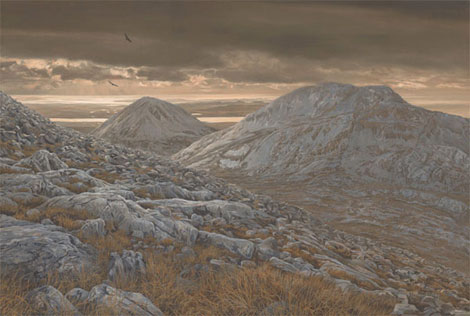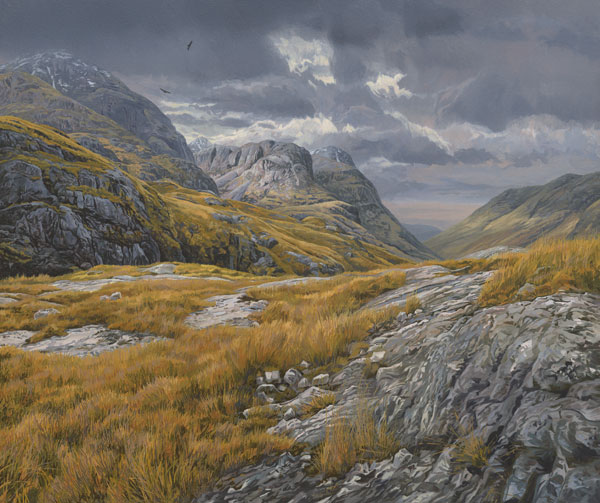
Golden Eagle Pictures
Images of golden eagles (Aquila chrysaetos)
GOLDEN EAGLE PICTURES
As you can see golden eagles are one of my favourite subjects, my spirits are lifted whenever I see an eagle. The first painting was created using a very limited colour palette. I only used burnt sienna, ultramarine and white. As an exercise it was very interesting as the resulting painting was still a very close representation of the natural autumn colours.
Eagles are able to soar for long periods of time with little effort. They catch rising masses of warmer air, which carry them upwards in a spiral fashion.
Golden Eagles (Aquila chrysaetos)
This huge bird of prey has a wingspan of 6.5 to 7.5 ft (1.8 to 2.3 m) MALE 3.5-4 kg (8-9 lb.) FEMALE 4.5-6 kg (10-14 lb.). Only the white-tailed eagle is larger in the United Kingdom. Golden Eagles are are dark brown, with lighter golden-brown plumage on their heads and necks. Immature birds can be recognised by the presence of distinct white patches on the under-wing and by a large white tail with dark band. Golden Eagles are extremely fast in the air, and can dive upon their prey at terrific speeds.
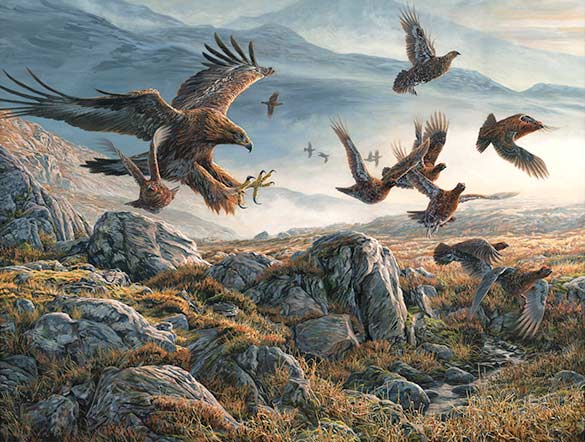
Golden Eagle & Red Grouse, An eagle swoops in on a covey of red grouse
Original oil painting
image 36 x 48 inches
Sold 17/2/22 Currency Converter
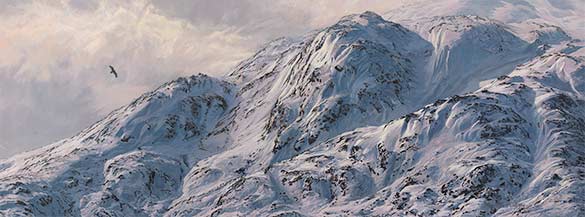
Glen Affric, Golden eagle
Original oil painting
image 12 x 32 inches
Sold 17/5/21 Currency Converter
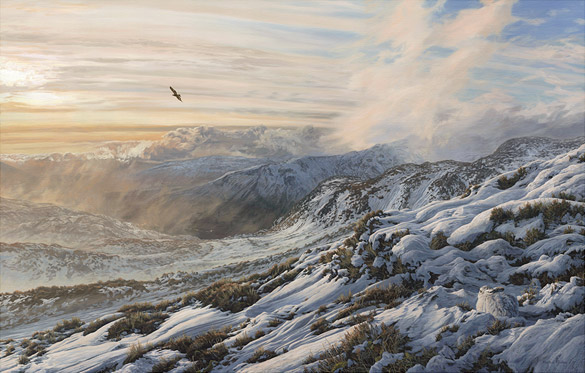
"Narrow Escape" Golden Eagle and Mountain Hare, Ben Halton, Comrie
Original oil painting
First painting in the series "Survival - Golden Eagle versus Mountain Hare"
image 34 x 54 inches
£13350 Sold Currency Converter
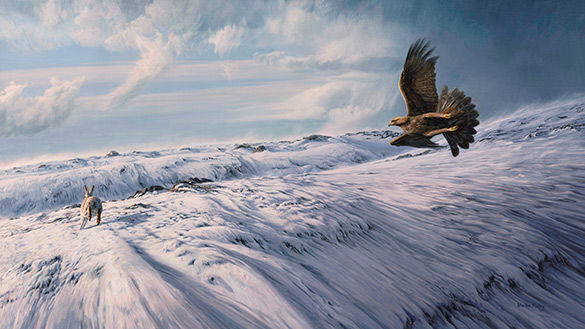
"Heading for the Gully", Golden Eagle Chasing a Mountain Hare
Original oil painting
Second painting in the series "Survival - Golden Eagle versus Mountain Hare"
Created with the help of eagle reference material supplied by Jiayi Chong
image 26 x 46 inches
FOR SALE
Currently on exhibition - John Muir Trust, Pitlochry
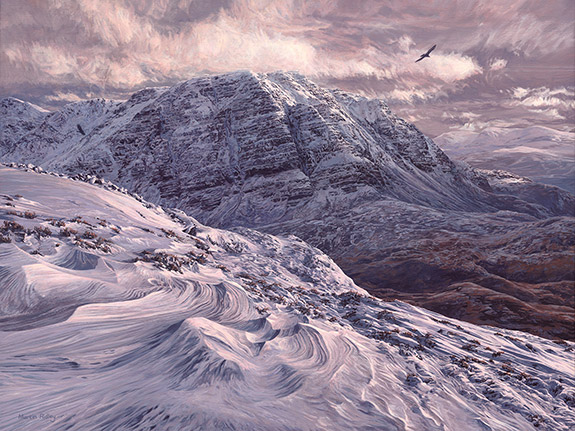
"Slioch", Golden Eagles
Original oil painting
image 30 x 40 inches
SPECIAL COMMISSION Sold 15/12/19 Currency Converter
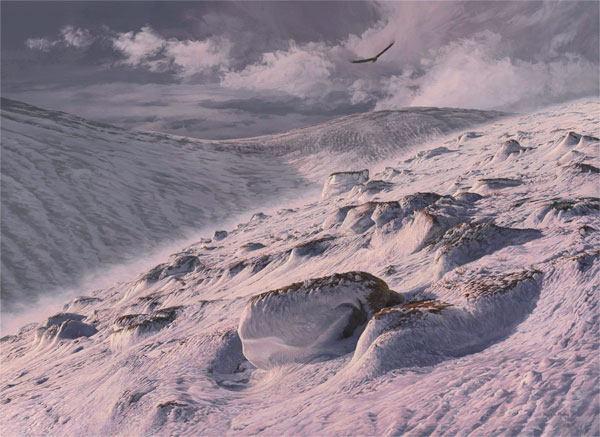
Golden Eagle over the Sron Riach ridge, Ben Macdui
Original oil painting
image 36 x 50 inches
£14750, Sold 7/7/13 Currency Converter

Golden Eagle and Deer Paths
Original oil painting
image 24 x 36 inches
Sold
Eagles are a very important part of the environment. As hunters they keep animal populations strong. They do this by killing weak, old, and slower animals, leaving only the healthiest to survive. Golden eagles prefer to attack upwind, which increases both their ability to control speed and maneuverability. They also feed on carrion, which unfortunately sometimes results in death from poisoning.
Shop Items
Golden Eagle Prints for Sale
The first few prints depict golden eagles then I've included some other birds of prey.
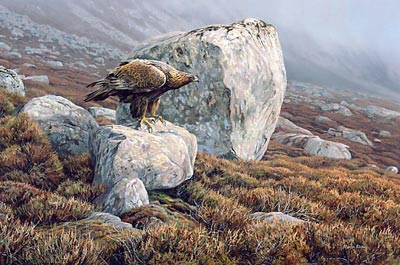
Golden Eagle
Available as a canvas print or a framed print

Limited edition giclee print reproduced from an original oil painting
Prints are signed by the artist
The prints are on Somerset Velvet watercolour paper (100% cotton, acid free)
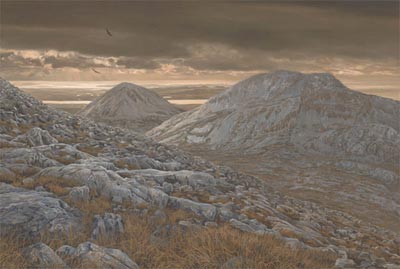
Canvas prints reproduced from an original oil painting
The prints are on heavy weight canvas with a matt laminate surface
Golden Eagle Facts
Habitat
Suitable golden eagle territory can be anything from sea level to several thousand feet, occupying most of the open terrain of deserts, mountains, plateaus, and steppes in the Northern Hemisphere. They prefer more open country away from human disturbance and are not usually found in heavily forested areas. Golden Eagles living in the northern part of their range move south when the food supply becomes scarce in the winter.
Diet
Golden Eagles prey mostly upon medium-sized rodents, rabbits, and hares, but also on birds, especially game birds, reptiles, and carrion. Most prey is taken on the ground from a low flight, but they are fast enough to take birds in flight. Some Golden Eagle pairs will hunt together.
Reproduction
Golden eagles art long-lived birds, with a life span believed to be around 30 years or even more. Eagles pair for life and defend a large territory. Both the male and female help in building the nest, occasionally in a tree but more often on a cliff ledge. The nest is made of sticks and branches. Since the same nest may be used and added to almost every year they can become very large, spanning as much as 2.4-3 m (8-10 ft) across and 0.9-1.2 m (3-4 ft) deep! Pairs may use the same nest every year or alternate among a few nest sites in their territory. Golden Eagles lay 2-4 eggs that are incubated 34 - 45 days. The eaglets fledge 9 - 11 weeks later, but only reach sexual maturity and obtain adult coloration at 4-5 years of age.
Where to see them
Eagles live in the wildest of places, the open moorlands and mountains of Scotland, favouring islands and remote glens. Eagles have traditional territories and nesting places which may be used by generations. Best looked for soaring high over hillsides in the Scottish Highlands. The few English eagles can be looked for at the RSPB's Haweswater reserve and watchpoint in Cumbria.
When to see them
They can be seen all year round, but look for displaying birds, with their looping and plunging flights, on fine days in February and March.
More about Golden Eagles via EXTERNAL LINKS
Golden Eagles (Fact Sheet from the RSPB)
Golden Eagles (BTOweb BirdFacts)

